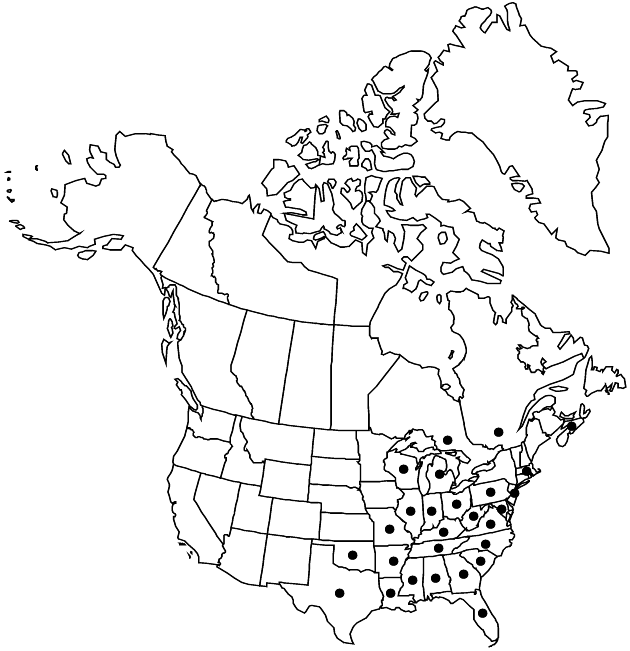Difference between revisions of "Helenium flexuosum"
New Fl. 4: 81. 1838.
FNA>Volume Importer |
imported>Volume Importer |
||
| (6 intermediate revisions by 2 users not shown) | |||
| Line 8: | Line 8: | ||
}} | }} | ||
|common_names=Purplehead sneezeweed;hélénie nudiflore | |common_names=Purplehead sneezeweed;hélénie nudiflore | ||
| + | |special_status={{Treatment/ID/Special_status | ||
| + | |code=E | ||
| + | |label=Endemic | ||
| + | }} | ||
|basionyms= | |basionyms= | ||
|synonyms={{Treatment/ID/Synonym | |synonyms={{Treatment/ID/Synonym | ||
|name=Helenium nudiflorum | |name=Helenium nudiflorum | ||
|authority=Nuttall | |authority=Nuttall | ||
| + | |rank=species | ||
}} | }} | ||
|hierarchy=Asteraceae;Asteraceae tribe Heliantheae;Asteraceae (tribe Heliantheae) subtribe Gaillardiinae;Helenium;Helenium flexuosum | |hierarchy=Asteraceae;Asteraceae tribe Heliantheae;Asteraceae (tribe Heliantheae) subtribe Gaillardiinae;Helenium;Helenium flexuosum | ||
| Line 27: | Line 32: | ||
|elevation=10–900 m | |elevation=10–900 m | ||
|distribution=N.S.;Ont.;Que.;Ala.;Ark.;Fla.;Ga.;Ill.;Ind.;Ky.;La.;Md.;Mass.;Mich.;Miss.;Mo.;N.J.;N.C.;Ohio;Okla.;Pa.;S.C.;Tenn.;Tex.;Va.;W.Va.;Wis. | |distribution=N.S.;Ont.;Que.;Ala.;Ark.;Fla.;Ga.;Ill.;Ind.;Ky.;La.;Md.;Mass.;Mich.;Miss.;Mo.;N.J.;N.C.;Ohio;Okla.;Pa.;S.C.;Tenn.;Tex.;Va.;W.Va.;Wis. | ||
| − | |discussion=<p>It has been suggested that Helenium flexuosum may be of hybrid origin from H. campestre (perennial, 2n = 28) and some member of Helenium sect. Tetrodus (H. F. L. Rock 1957). The only member of sect. Tetrodus that has a chromosome number of 2n = 28 is H. linifolium, an annual from southern Texas.</p> | + | |discussion=<p>It has been suggested that <i>Helenium flexuosum</i> may be of hybrid origin from <i>H. campestre</i> (perennial, 2n = 28) and some member of <i>Helenium</i> sect. Tetrodus (H. F. L. Rock 1957). The only member of sect. Tetrodus that has a chromosome number of 2n = 28 is <i>H. linifolium</i>, an annual from southern Texas.</p> |
|tables= | |tables= | ||
|references= | |references= | ||
| Line 36: | Line 41: | ||
-->{{#Taxon: | -->{{#Taxon: | ||
name=Helenium flexuosum | name=Helenium flexuosum | ||
| − | |||
|authority=Rafinesque | |authority=Rafinesque | ||
|rank=species | |rank=species | ||
| Line 50: | Line 54: | ||
|publication title=New Fl. | |publication title=New Fl. | ||
|publication year=1838 | |publication year=1838 | ||
| − | |special status= | + | |special status=Endemic |
| − | |source xml=https:// | + | |source xml=https://bitbucket.org/aafc-mbb/fna-data-curation/src/2e0870ddd59836b60bcf96646a41e87ea5a5943a/coarse_grained_fna_xml/V19-20-21/V21_1073.xml |
|tribe=Asteraceae tribe Heliantheae | |tribe=Asteraceae tribe Heliantheae | ||
|subtribe=Asteraceae (tribe Heliantheae) subtribe Gaillardiinae | |subtribe=Asteraceae (tribe Heliantheae) subtribe Gaillardiinae | ||
Latest revision as of 20:07, 5 November 2020
Perennials, 30–100 cm. Stems usually 1, usually branched distally, strongly winged, glabrous or sparsely hairy proximally, sparsely to moderately hairy distally. Leaves glabrous or sparsely to moderately hairy; basal blades oblanceolate to obovate or spatulate, entire or serrate; proximal and mid blades oblanceolate to lanceolate, entire or toothed; distal blades lanceolate to lance-linear, entire. Heads (1–)5–50(–80+) per plant, in paniculiform arrays. Peduncles 3–10 cm, sparsely to moderately hairy. Involucres globoid to usually ovoid, 8–17 × 9–17 mm. Phyllaries (connate proximally) moderately to densely hairy. Ray florets usually 8–13, neuter, sometimes 0; corollas yellow to reddish brown to red to purple, 10–20 × 5–10 mm. Disc florets 250–500(–700+); corollas yellow proximally and purple distally or purple throughout, 2.3–3.7 mm, lobes 4(–5). Cypselae 1–1.2 mm, moderately hairy; pappi of 5–6 entire, aristate scales 0.6–1(–1.7) mm. 2n = 28.
Phenology: Flowering (Apr–)May–Jul(–Oct).
Habitat: Ditches, fields, washes, along streams
Elevation: 10–900 m
Distribution

N.S., Ont., Que., Ala., Ark., Fla., Ga., Ill., Ind., Ky., La., Md., Mass., Mich., Miss., Mo., N.J., N.C., Ohio, Okla., Pa., S.C., Tenn., Tex., Va., W.Va., Wis.
Discussion
It has been suggested that Helenium flexuosum may be of hybrid origin from H. campestre (perennial, 2n = 28) and some member of Helenium sect. Tetrodus (H. F. L. Rock 1957). The only member of sect. Tetrodus that has a chromosome number of 2n = 28 is H. linifolium, an annual from southern Texas.
Selected References
None.